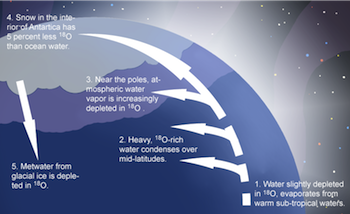The Theme of Agriculture in Environmental Chemistry
Isotopes have been used to determine the ages of artifacts, track criminals, and verify the origins of bottled water. Since the section is labeled agriculture, we will focus on the use of isotopes to track food, wine, and drugs.
The glamorous task of tracking down the source of your beef and veggies falls primarily to the O-18 and H-2 isotopes8. The isotopic ratios in precipitation (and tap water) vary geographically. This means that we can determine where your cow or broccoli has been by comparing its isotopic ratios to known ratios. O-18 is like a tracking device that indicates everywhere your burger or salad has been.
Let's get into the nitty-gritty of it to see how this really works. O-18 is obviously heavier than O-16. This means that O-18, or heavy oxygen, will fall with the rain first. As the rain moves toward higher latitudes, however, there is less and less heavy oxygen and more light oxygen. The general pattern is that as you move from the equator to the poles, the rain has smaller and smaller O-18 to O-16 ratios, with the mid-latitudes enjoying O-18 rich precipitation.

Patterns in oxygen isotopes in precipitation.
Other factors, besides latitude, also influence the amount of heavy oxygen in precipitation. Coastal areas, for example, tend to have higher concentrations of O-18 and H-2. This page shows isotopic concentrations in hair across the US.
The movements and location of almost anything found on earth can be traced using isotopic ratios. The origins of your wine, your bottled water, your hamburger: these are all traceable using isotopes. There is hope that using isotopes will help identify the source of outbreaks of food-borne illnesses. In the future, we might even be able to differentiate between organically grown and conventionally grown crops using isotopes.
Isotopes have already been used to trace the source of illicit drugs like cocaine. Using N-14 to N-15 ratios and C-13 to C-12 ratios, scientists can determine the exact location the coca plants were grown. Part of their ability to do so has to do with the biology of the plant itself. Coca plants in humid environments open their stomata more, which leads to an increase in the amount of carbon dioxide taken into the plant. Enzymes in the plant are like picky toddlers and take up C-12 rather than C-13, meaning that plants in humid regions have a lower C-13 to C-12 ratio than plants in drier regions. The ratios of N-14 to N-15 also vary by region and so can be used to pinpoint the source of the drugs.